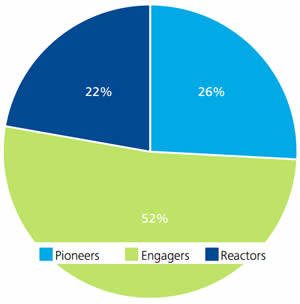|
|
For both companies and individuals, technology has unleashed the potential creation of a virtuous energy cycle: By understanding and managing energy use, individuals save money, companies increase profits, and both lessen the environmental impact. Everyone wins.
A recent report by Deloitte—the reSources 2012 Study— found consumer resourcefulness has become entrenched among American consumers. Eighty-three percent of consumers took steps to reduce their electric bills over the past year, up from 68% in the 2011 reSources Study. And, consumers are demanding that companies offer more environmentally considerate solutions. U.S. businesses, on average, are targeting reductions in energy consumption of 23-24% over a 3-4 year period across electricity, natural gas, and transportation fleet. This year’s survey indicates that companies are increasingly recognizing energy management as a necessary strategic discipline and a key to competitiveness. The 2011 and 2012 studies suggest there are three categories where businesses will fall as it relates to their energy management practices—Pioneers, Engagers and Reactors.


Organizations are increasingly sophisticated at managing energy at multiple levels within their enterprise and across the supply chain.
Danger ahead—A license to operate?
The breakneck pace of the energy technology revolution likely masked inherent risks, however—especially in terms of the environment and the public reaction.
The expansion of “hydraulic fracturing” and the accelerated production of the Canadian oil sands, coincided with the global economic crisis that began in 2008. This initially blunted reaction to the potential dangers of new energy technologies, since the general public was absorbed by its core economic concerns and thus inclined to think more about the savings that came from less-expensive energy than about environmental concerns. In parallel, the campaign for a global climate treaty effectively collapsed after Copenhagen in 2009, upending the momentum to curb carbon emissions. In other words, in the competition between desire (for cheaper energy) and fear (of the eco-consequences of fossil fuels), desire was at the forefront.
But environmental concerns are again front-and-center. The past three years have seen a series of energy-linked environmental challenges that have reawakened public concerns: The Gulf of Mexico oil spill, the Fukushima nuclear incident, the controversy of hydraulic fracturing, and more.
Another example is the 1,700-mile Keystone XL pipeline (which would transport 700,000 barrels per day of Canadian oil sands crude to U.S. Gulf coast refineries) which has stirred a storm of controversy in Washington after concerns were raised about carbon emissions from oil sands production. The grassroots movement against hydraulic fracturing, meanwhile, has gained steam due to concerns about the potential contamination of ground water, risks to air quality, and the possible migration of gases and hydraulic fracturing chemicals to the surface. In January 2012, over 40,000 New Yorkers weighed in during the public comment period on the State’s deliberations to allow hydraulic fracturing.
The concerns of the ecological crowd are receiving attention, with some reports showing that groundwater tends to contain higher concentrations of methane near hydraulic fracturing wells. Also, hydraulic fracturing has been linked to earthquakes—not yet proven but sowing distrust. In November 2011, an earthquake measuring 5.6 rattled Oklahoma and was felt as far away as Illinois. Until two years ago, Oklahoma typically had about 50 earthquakes a year, but in 2010, 1,047 quakes shook the state. Both the U.S. Army and the U.S. Geological Survey have concluded that the practice of injecting water into deep rock formations causes earthquakes. The unsettled nature of these concerns means that companies still have not secured a free-and-clear “license to operate” from the public.
These are the early days of the high-tech energy era. Our knowledge of the potential and the consequences of new technologies is in its infancy. The full cast of players in ‘Great Game 2.0’—states, technology companies, energy producers—is only now emerging onto the stage. How all of these forces interact and play out in the coming years could well determine not just where we get our energy from and how much it costs, but also the shape of domestic and global development. The ‘Great Game 2.0’ may well decide which countries and companies emerge as enduring powers in the 21st century—which ones, in other words, will reach the pot of gold at the end of the energy rainbow.>>>
[ 1 ] [ 2 ] [ 3 ] [ 4 ] [ 5 ] [ 6 ] [ 7 ] [ 8 ] [ 9 ] [ 10 ] |

